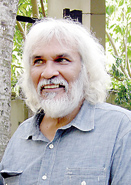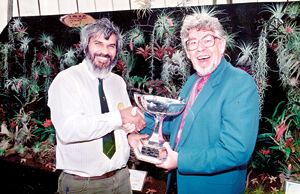A life as colourful as his canvas
By the tender age of five, Mike Harridge was already an avid horticulturalist. He remembers his mother’s garden in their home in Havelock Town being crowded with fruit trees – jak, mango, guava and custard apple. For a little boy interested in the natural world, it was a paradise and he grew up on friendly terms with the lizards, frogs and tortoises that scurried, leapt and crawled across their land.

One of Mike’s paintings: Meconopsis betonicifolia
He shared this love of animals with his brothers but unlike them he wasn’t very athletic – a case of childhood polio had affected his legs but not his happy temperament.By the time he was four, he was growing spring onions and spinach for their dining table, all the while dreaming of becoming a trapeze artist. What he would actually become was a welder, then an extractor of snake venom, then a keeper of tropical fish…all before he moved to England as a young man and launched into another series of careers. When Mike says he has “meandered” through life, he is not exaggerating.
Enrolled at St. Peter’s College in Colombo, Mike was also an artist from a young age. It would remain the one passion that transcended his shifting interests. (Despite the fact that as an adult he would sell out his debut exhibition, as a child he never won first place. Second prize was never as good as first – a box of paints vs. tube paints.) Having returned home after many years in England, Mike is preparing to stage his first exhibition in Sri Lanka at the Barefoot Gallery. It will be his largest solo effort so far, with 60 paintings drawn from across a decade of work on display. It’s a very varied collection, ranging from landscapes and abstracts to macro-paintings of flowers and viruses. His pieces have in common though the use of brilliant colours and very intricate detailing.
Tall, with a halo of windblown white hair, his polio injury, aggravated by no less than three auto-rickshaw accidents and arthritis, Mike today uses crutches – “chopsticks,” he calls them – to get about. “It never held me back,” he says of his injury. A short attention span, which he refers to variously as “ants in the pants” and “excess Burgher syndrome” means he’s constantly on the move. His return to painting marks the end of a long drought during which he only sketched a little to keep his hand in.

Back home: Mike at the Barefoot. Pic by Athula Devapriya
While the move back to Sri Lanka has brought Mike’s artistry to the fore, it has also meant he is no longer an active gardener. However, this phase was prefaced by a ten-year run filled with extraordinary achievements. Beginning in 1992, Mike won the gold medal in six consecutive years at the iconic Chelsea Flower Show, managing to garner 150 gold medals and four silver medals in a various horticultural competitions by the end of the decade. Like so much else in his life, it all happened quite by chance.
When Mike left St. Peter’s, he chose to study welding, for no other reason than that he loved how the sparks flew from the welding torches. Having learned different techniques and how to approach various metals, he promptly abandoned it for most part, only returning to it in later years when he became interested in sculpture. Then came the jobs with friends – one extracting snake venom, surveys on the fresh water fish of Sri Lanka, a spell studying tree frogs and another taking care of tropical fish – before Mike set off for Guatemala via England in 1972. “I had a real fascination for Guatemala, but I didn’t get there till much later,” he says. “I loved England. It was like entering a birthday cake.” It was a world of concerts and vinyl records, parties and fun times with Sri Lankan friends who had also made the move.
It was there he would meet Liz David Jones, a native of Leeds who would become the mother of his boys. Another avid gardener, her family originally hailed from the Lake District. With his romantic life blooming, Mike picked up where he left off professionally, taking on work at an aquatic nursery in Hampton. He then joined the team at the Leeds City Museum where he was put in charge of their collection of live animals which included snakes, lizards, spiders, frogs and fish. Before he got there, they were losing huge numbers of animals but Mike brought to his job an understanding of what the creatures really needed. He created little habitats complete with places to hide and sources of water, and then sat back and allowed his charges to breed in comfort. He found that he had a real knack for the task.
He was still drawing and upon seeing some of his paintings, a colleague from the museum encouraged him to enrol in the Jacob Kramer College of Art. Mike would study under Pam Rex there between 1975 and 1977, holding his first exhibition under their auspices. On the side, he had become interested in cultivating tropical plants, specializing particularly in bromeliads which he loved for their varied shapes and colours. He would source his plants in Sri Lanka and even eventually from Guatemala. He left his own garden to his brilliant wife, but he did interiors for private clients. His plant business got so demanding that he stopped painting almost as soon as he graduated.
It was while attending a plant trade show set up by John Ravenscroft, that Mike’s small stand drew the attention of Bob Woolley, then the Director of the Gateshead Garden Festival. He invited Mike to do a display for the upcoming competition in the June of 1990. After multiple reassurances that he wouldn’t have to pay for the honour, Mike accepted. He had never done a display before and the location was a huge arena, packed with international teams including the Americans, the Dutch and the Germans. Mike was horrified to discover that Bob had allotted him a 20ft by 40ft display right at the entrance. “I said ‘yikes!’, ‘Christ on a bike! How am I going to do it?’” Mike had only his bromeliads but Bob provided all the taller plants, as well as sand, rocks and driftwood.

One of many bromeliad wins: Receiving a trophy for yet another stunning display
Establishing a routine that he would follow in every subsequent competition, Mike started to work without stopping to sketch any plan, designing purely by instinct. He applied what he had learned from Pam in his art classes and began creating his tableau from the centre outward. For his theme he chose a jungle, albeit a very manicured one. (Typically his palette would be made up of anywhere from between 3,000 – 5,000 plants – the number needed to fill spaces as large as this.) He worked through the night and was ready for the judges when they arrived early the next morning and was astonished to be declared ‘Best in Show’.
“That was the first show I did. From there it just steam rollered,” says Mike. He still hadn’t had a shower from the evening before, but he found himself on television giving interviews. From Gateshead, he was invited by the Royal Horticultural Society to compete and in that first year itself, was honoured with an invitation to participate in Chelsea Flower Show. Throughout, he continued to grow bromeliads. His particular specialty was the tillandsia genus which boasted over 500 varieties. It was at one competition that he found himself explaining to two men, who he would only later discover were Prince Phillip, Duke of Edinburgh and Lord Cavendish, that epiphytes were no threat to other plants. (Though they may grow without soil they absorb nutrients through their leaves.) Somewhere else in the room, also going unrecognized by Mike, was George Harrison.
“At my peak I did 27 shows a year, all major shows…After that I just got tired. It was too much.” He would eventually withdraw from competition because of the increasing demand for his services. Commissions poured in from exotic locales like the Seychelles, Nicaragua and Chile and he, an ever enthusiastic traveller, took them on. Yet, now that he’s back to being a painter more or less full time, Mike doesn’t seem to miss those years at all. His philosophy is simple: “For me nothing else exists except what is happening here and now.” Between his own talent and the support of friends and family, things have turned out well for Mike. He says shrugging, “One thing has simply led to another thing. I never planned any of it.”



